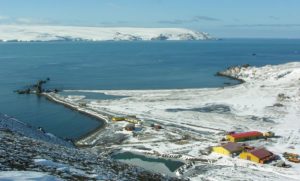We have already came across the Huts at the Sub-Antarctic Macquarie Island (WAP AUS-Ø8), on last april 2019, see: http://www.waponline.it/a-quick-tour-among-the-huts-at-macquarie-island/.
Today we’ll have a brief tour through the historical Huts on the same island:
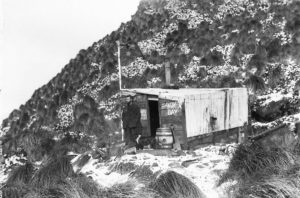 Historic Old Sandy Bay Hut Everyone on the island, and all the tourists who visit, are familiar with the little old field hut at Sandy Bay. It is solid as a rock and banded with rusty iron, tussocks grow on top and roosting skuas keep watch over the surrounding king penguin colony. It is a picturesque sight.
Historic Old Sandy Bay Hut Everyone on the island, and all the tourists who visit, are familiar with the little old field hut at Sandy Bay. It is solid as a rock and banded with rusty iron, tussocks grow on top and roosting skuas keep watch over the surrounding king penguin colony. It is a picturesque sight.
The door bolt is rusted shut, but expeditioners can peer in the grubby window at a dark, decrepit interior festooned with penguin-moult feathers caught up in spider webs – very atmospheric. Feathers from moulting penguins can be found everywhere, as we know from doing our weekly communal clean-up duties. It is amazing how they can sneak through the tiniest crevices in buildings.
Historic Old Lusitana Bay Hut
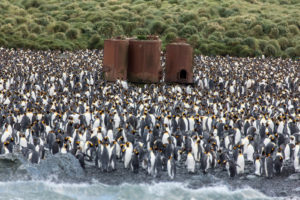 The little old Hut at Lusitania Bay (54° 42′ South, 154°50′ East) just north of the king penguin colony. The huts are old Walrus aircraft engine packing crates, put in place in 1949. They served as field huts for many years and still could have, no doubt, except that the king penguin colonies at Sandy Bay and Lusitania Bay overtook them both and they were abandoned in favour of the new huts at Brothers Point and Waterfall Bay. (pic aside show Lusitania Bay’s penguin colony)
The little old Hut at Lusitania Bay (54° 42′ South, 154°50′ East) just north of the king penguin colony. The huts are old Walrus aircraft engine packing crates, put in place in 1949. They served as field huts for many years and still could have, no doubt, except that the king penguin colonies at Sandy Bay and Lusitania Bay overtook them both and they were abandoned in favour of the new huts at Brothers Point and Waterfall Bay. (pic aside show Lusitania Bay’s penguin colony)
Other Huts at Macquarie Island
Huts and try works were located at the Isthmus, Sandy Bay, Lusitania Bay, Caroline Cove and Hurd Point. Russian explorer Thaddeus Bellingshausen visited Macquarie Island in 1820 and reported that a total of 40 men were working on the island. He also left an interesting description of the sealers hut at Sandy Bay which was:
20 feet long by 10 feet broad, inside it was lined with skins of seals, the outside was covered with a kind of grass which grows on the island. At one end was a small hearth, and a lamp was always kept alight. … Beside the hearth was a bedstead. Provisions were stored at the other end of the hut. Inside it was so black and dark from the smoke that the smouldering light from the lamp and from the holes in the wall over which bladders were stretched, scarcely lit the interior of the hut, and until we got accustomed to the light the sealers had to lead us by the hand.
Let’s have a look to the others removed Huts:
With the long awaited recognition that Macquarie Island was cat free this last season, there was no longer any justification for the presence of the three plateau Field Huts that had been established some years ago to provide accommodation for the Tasmanian Parks and Wildlife staff involved in the cat eradication project, part of the Vertebrate Pest Management Program:
They were:
Mt Eitel Hut (54° 36.6′ South, 158° 50.9′ East),
Lake Tiobunga Hut (54° 41.7′ South, 158° 49.2′ East)
Windy Ridge Hut (54° 44.0′ South, 158° 49.8′ East).
Another Hut was established at Davis Point in 1993 for the purpose of conducting the marine debris survey.
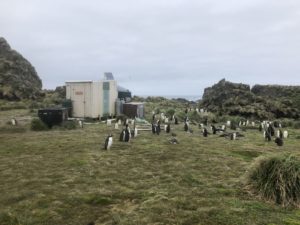 Davis Point Hut (54° 39.9′ South, 158° 49.5′ East) There is a small hut at Davis Point (pic aside) used for special fieldwork and as a refuge, which catches rain water off the roof. Davis Point hut is a cross country transit to Green Gorge Hut
Davis Point Hut (54° 39.9′ South, 158° 49.5′ East) There is a small hut at Davis Point (pic aside) used for special fieldwork and as a refuge, which catches rain water off the roof. Davis Point hut is a cross country transit to Green Gorge Hut
The Davis Point Hut is one of seven shelters dropped across the island for hunters and their dogs tracking rabbits. They were a vital part of the Macquarie Island eradication of pests.
As this work will now be centered on Bauer Bay, there was no longer any need for this hut to remain on the island. Mt Eitel apple hut packed up. Rat-proof cage pallet in foreground. March 2003
When the ship arrived at the end of March, the helicopters were deployed to lift both the Davis Point Hut and the three apple huts from the plateau, by cable sling and transport them back to the main station area. Each hut was accompanied by two pre-packed cage pallets, gas bottles and a black rat-proof cage pallet with perishable items such as food. It took about three to four hours of work to totally remove each of the apple huts and their contents.
All four huts were then transported by helicopter from the Isthmus to the ship ready for return to Australia.
Source: http://www.antarctica.gov.au/about-antarctica/history/exploration-and-expeditions/modern-expeditions/this-week-in-antarctica/2003/macquarie-island2/out-they-come-macquarie-is-field-hut-removal
REFUGES (HUTS)
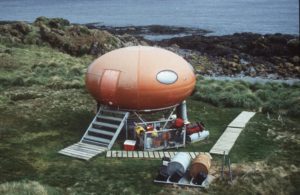 Brothers Point 54° 34.4′ South, 158° 55.1′ East (pic on the right show the Googie Hut at Brother’s point)
Brothers Point 54° 34.4′ South, 158° 55.1′ East (pic on the right show the Googie Hut at Brother’s point)
Davis Point 54° 39.9′ South, 158° 49.5′ East
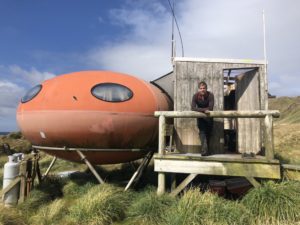 Waterfall Bay Hut (pic on the left) located at 54° 41.5′ South, 158° 51.9′ East
Waterfall Bay Hut (pic on the left) located at 54° 41.5′ South, 158° 51.9′ East
Tiobunga 54° 41.7′ South, 158° 49.2′ E
Windy Ridge 54° 44.0′ South, 158° 49.8′ East
Caroline Cove 54° 45.8′ South, 158° 47.5′ East
Thanks and credit to the following web sites:
http://www.antarctica.gov.au/about-antarctica/history/stations/macquarie-island
http://www.antarctica.gov.au/living-and-working/stations/macquarie-island/this-week-at-macquarie-island/2016/this-week-at-macquarie-island-16-december-2016
http://bazintaz.blogspot.com/2013/11/seven-days-on-island-part-3.html
http://macquarieislandisland.blogspot.com/
 Food wrapping, fishing gear and plastic waste continue to reach the Antarctic. Two new studies into how plastic debris is reaching sub-Antarctic islands are published last month of April 2020 in the journal Environment International.
Food wrapping, fishing gear and plastic waste continue to reach the Antarctic. Two new studies into how plastic debris is reaching sub-Antarctic islands are published last month of April 2020 in the journal Environment International.
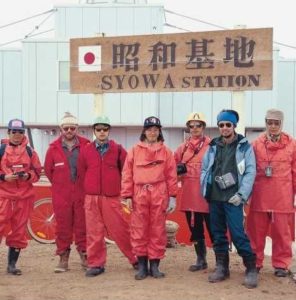 Beside Asuka Base (WAP JPN-Ø1) and Miizhuo (WAP JPN-Ø2) Showa or Syowa Station is the 3rd Japanese permanent research station in Antarctica. The fourth one is Dome Fuji (WAP JPN-Ø4).
Beside Asuka Base (WAP JPN-Ø1) and Miizhuo (WAP JPN-Ø2) Showa or Syowa Station is the 3rd Japanese permanent research station in Antarctica. The fourth one is Dome Fuji (WAP JPN-Ø4).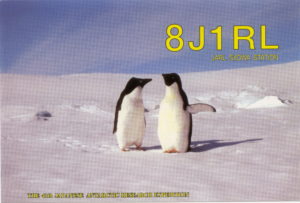
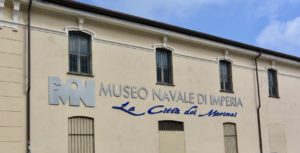 Well, the city of Imperia by the Ligurian Riviera (Italy) is waiting you next September 11, 12 and 13 2020 at the International Naval Museum of Western Liguria .
Well, the city of Imperia by the Ligurian Riviera (Italy) is waiting you next September 11, 12 and 13 2020 at the International Naval Museum of Western Liguria . Flavio Barbiero (pic aside) lives in Italy. He is a retired Admiral in the Italian Navy who last served with NATO. In addition He is an archaeological researcher in Israel as well as the author of several books, including “The Bible without secrets” and “The secret Society of Moses”.
Flavio Barbiero (pic aside) lives in Italy. He is a retired Admiral in the Italian Navy who last served with NATO. In addition He is an archaeological researcher in Israel as well as the author of several books, including “The Bible without secrets” and “The secret Society of Moses”.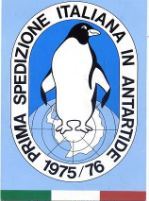 In his website, Flavio Barbiero describes the First Expedition to Antarctica by Renato Cepparo, with rare pics.
In his website, Flavio Barbiero describes the First Expedition to Antarctica by Renato Cepparo, with rare pics.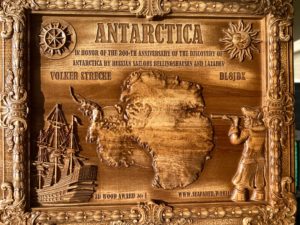 Antarctic Veteran, Dr. Volker Strecke, DL8JDX has just received the
Antarctic Veteran, Dr. Volker Strecke, DL8JDX has just received the 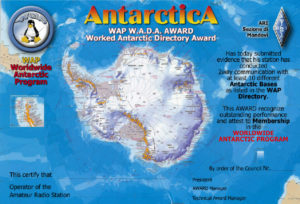 Thanks to
Thanks to  IK1GPG Max, WAP Award manager at (
IK1GPG Max, WAP Award manager at ( A sudden fire broke out at the Russian Antarctic station “Mirny”
A sudden fire broke out at the Russian Antarctic station “Mirny”  200 years is an important Anniversary and the well known at WW level: “Russian Robinson Club “ is happy for the highest participation achieved by the program in honor of the bi-centenary of discovering Antarctica.
200 years is an important Anniversary and the well known at WW level: “Russian Robinson Club “ is happy for the highest participation achieved by the program in honor of the bi-centenary of discovering Antarctica.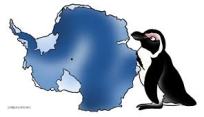 June 21 is the shortest day of the year, when in the southern hemisphere the winter begins. It is a tradition in this day, to commemorate the “
June 21 is the shortest day of the year, when in the southern hemisphere the winter begins. It is a tradition in this day, to commemorate the “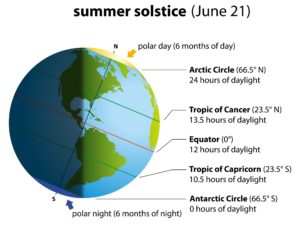 The summer solstice usually falls on June 21, and is said to mark the onset of summer in the Northern Hemisphere. It occurs when the North Pole is the nearest to the Sun. It is derived from the Latin word ‘sol‘ which means ‘sun’, and ‘sistere‘, which means ‘to stand still’ and occurs two times in a year, once in each hemisphere.
The summer solstice usually falls on June 21, and is said to mark the onset of summer in the Northern Hemisphere. It occurs when the North Pole is the nearest to the Sun. It is derived from the Latin word ‘sol‘ which means ‘sun’, and ‘sistere‘, which means ‘to stand still’ and occurs two times in a year, once in each hemisphere.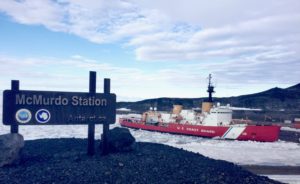
 The Bove Commission (COM-BO) is formed by a group of experts and volunteers from governmental and private institutions, with the common goal of getting more historic information on the dismantling of the Italian Giacomo Bove Station in Antarctica (WAP ITA-Ø1).
The Bove Commission (COM-BO) is formed by a group of experts and volunteers from governmental and private institutions, with the common goal of getting more historic information on the dismantling of the Italian Giacomo Bove Station in Antarctica (WAP ITA-Ø1).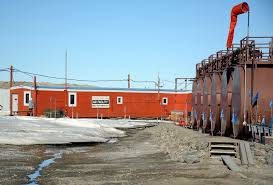 Marble Point, (
Marble Point, (
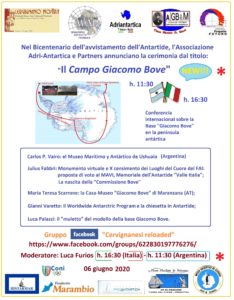 We are talking about a place (MAVI) entering in a challenge launched by FAI (Fondo Ambiente Italiano). Since 1975, FAI – Fondo Ambiente Italiano, the National Trust for Italy, restores and takes care of special places in Italy so that present and future generations from all over the world, may enjoy a priceless legacy.
We are talking about a place (MAVI) entering in a challenge launched by FAI (Fondo Ambiente Italiano). Since 1975, FAI – Fondo Ambiente Italiano, the National Trust for Italy, restores and takes care of special places in Italy so that present and future generations from all over the world, may enjoy a priceless legacy.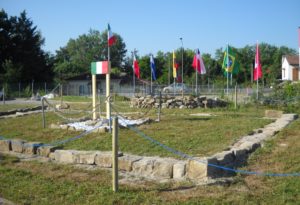 The “Valle Italia” Antarctic Memorial, Cèpparo-Bove (
The “Valle Italia” Antarctic Memorial, Cèpparo-Bove (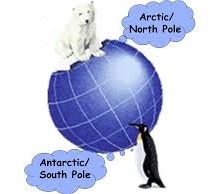 Arctic
Arctic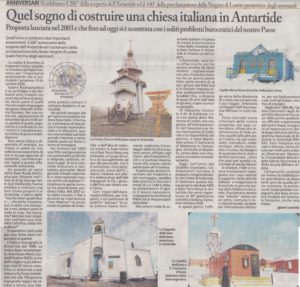 It’s an idea that comes from the heart, an idea that we have illustrated and explained in meetings, in several schools, to politicians, radio and TV, to bishops, cardinals and no less than 3 Popes in the last 13 years.
It’s an idea that comes from the heart, an idea that we have illustrated and explained in meetings, in several schools, to politicians, radio and TV, to bishops, cardinals and no less than 3 Popes in the last 13 years. When Argentina celebrates the “Dia de la Patria” our Ham friends of Ushuaia –Tierra del Fuego–
When Argentina celebrates the “Dia de la Patria” our Ham friends of Ushuaia –Tierra del Fuego–  Here, king penguins live in huge colonies. Their days are spent chomping on krill, squid and fish, feeding their chicks and producing ‘guano’, which means poo in penguin. Nothing mind-boggling about that, you might say.
Here, king penguins live in huge colonies. Their days are spent chomping on krill, squid and fish, feeding their chicks and producing ‘guano’, which means poo in penguin. Nothing mind-boggling about that, you might say.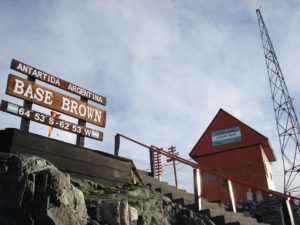 Brown Station (WAP ARG-Ø2) is an Argentine Antarctic Base and scientific research station named after Admiral William Brown, the father of the Argentine Navy.
Brown Station (WAP ARG-Ø2) is an Argentine Antarctic Base and scientific research station named after Admiral William Brown, the father of the Argentine Navy.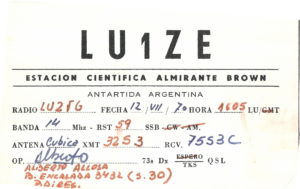 During the summer campaign of 1995–96 the Logistics Department of the Argentine National Antarctic Directorate built two new habitable modules: a laboratory and a house with amenities. In the 1999–2000 campaign the Directorate built a new main house capable of comfortably accommodating 8 people; the new building consists of 4 bedrooms, kitchen and 2 bathrooms. Brown slipped into several years of inactivity during the 2000s decade but since 2007 is occupied during the summer again. Paradise Harbor is a large sea inlet southwest of Andvord Bay protected by an arc formed by the Lemaire, Cramer and Bryde islands. Along the harbor’s deep water coast lies the small Sanavirón Peninsula, a rocky promontory crowned by a mound of almost 70 m (230 ft) high called Punta Proa, where the base facilities are located. In the area there are several beacons to help ship guidance: Punta Proa, in the homonymous place; Punta Vidt in General Ricchieri Cove; Punta Conesa, on the entrance to Puerto Leith; Hanka islet on the homonymous place in Paradise Harbor; Punta Piedras in Oscar Cove; and the lighthouse on Cramer Island.
During the summer campaign of 1995–96 the Logistics Department of the Argentine National Antarctic Directorate built two new habitable modules: a laboratory and a house with amenities. In the 1999–2000 campaign the Directorate built a new main house capable of comfortably accommodating 8 people; the new building consists of 4 bedrooms, kitchen and 2 bathrooms. Brown slipped into several years of inactivity during the 2000s decade but since 2007 is occupied during the summer again. Paradise Harbor is a large sea inlet southwest of Andvord Bay protected by an arc formed by the Lemaire, Cramer and Bryde islands. Along the harbor’s deep water coast lies the small Sanavirón Peninsula, a rocky promontory crowned by a mound of almost 70 m (230 ft) high called Punta Proa, where the base facilities are located. In the area there are several beacons to help ship guidance: Punta Proa, in the homonymous place; Punta Vidt in General Ricchieri Cove; Punta Conesa, on the entrance to Puerto Leith; Hanka islet on the homonymous place in Paradise Harbor; Punta Piedras in Oscar Cove; and the lighthouse on Cramer Island.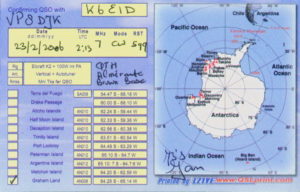 Brown is located 1,100 km (680 mi) from Ushuaia, the nearest port city. As of 2014 the base spans a total area of 1.4 ha (14,000 m2; 150,000 sq ft). It can house a maximum of 18 people. Research programs were developed for biology (zoology and botany), bacteriology, limnology, biochemistry, animal and human physiology, pathology, ecology, oceanography, meteorology, cosmic rays and ionospheric observations, environmental nuclear radiation, continental and sea ice glaciology, satellite geodesy, geology, geophysics, seismology, ozone monitoring and tide measurement.
Brown is located 1,100 km (680 mi) from Ushuaia, the nearest port city. As of 2014 the base spans a total area of 1.4 ha (14,000 m2; 150,000 sq ft). It can house a maximum of 18 people. Research programs were developed for biology (zoology and botany), bacteriology, limnology, biochemistry, animal and human physiology, pathology, ecology, oceanography, meteorology, cosmic rays and ionospheric observations, environmental nuclear radiation, continental and sea ice glaciology, satellite geodesy, geology, geophysics, seismology, ozone monitoring and tide measurement.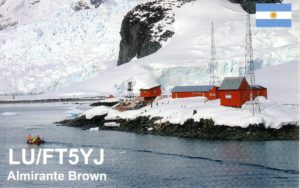 Throughout the years of research and observations at Brown, more than 100 scientific papers were published by the Argentine Antarctic Institute. Thanks to its location on the Antarctica continent along the beautiful Paradise Harbor and to its relatively mild weather, Brown Station is a popular excursion destination for tourist expedition ships visiting Antarctica. In addition to visiting gentoo penguins, tourists may climb to a viewpoint 84 m (276 ft) above the station.
Throughout the years of research and observations at Brown, more than 100 scientific papers were published by the Argentine Antarctic Institute. Thanks to its location on the Antarctica continent along the beautiful Paradise Harbor and to its relatively mild weather, Brown Station is a popular excursion destination for tourist expedition ships visiting Antarctica. In addition to visiting gentoo penguins, tourists may climb to a viewpoint 84 m (276 ft) above the station. It’s been 180 years since Charles Wilkes (April 3, 1798 – February 8, 1877) an American naval officer, ship’s captain, and explorer led the United States Exploring Expedition, 1838-1842. He voyaged to the Antarctic continent and his journey has never been more relevant!
It’s been 180 years since Charles Wilkes (April 3, 1798 – February 8, 1877) an American naval officer, ship’s captain, and explorer led the United States Exploring Expedition, 1838-1842. He voyaged to the Antarctic continent and his journey has never been more relevant!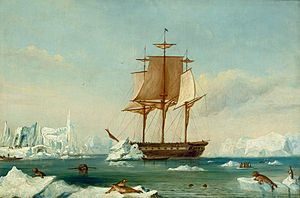 Amundsen might have been the first man to reach the South Pole, in 1911, but the discovery of the Antarctic continent occurred several generations earlier. In January 1840, when Wilkes was commander of the United States Exploring Expedition, he charted 1500 miles of the east Antarctic coastline in his flagship U.S.S. Vincennes (picure on the right, shows the 19th-century painting, based on a sketch by Lieutenant Charles Wilkes, USN, depicting USS Vincennes in Disappointment Bay, Antarctica, circa January–February 1840).
Amundsen might have been the first man to reach the South Pole, in 1911, but the discovery of the Antarctic continent occurred several generations earlier. In January 1840, when Wilkes was commander of the United States Exploring Expedition, he charted 1500 miles of the east Antarctic coastline in his flagship U.S.S. Vincennes (picure on the right, shows the 19th-century painting, based on a sketch by Lieutenant Charles Wilkes, USN, depicting USS Vincennes in Disappointment Bay, Antarctica, circa January–February 1840).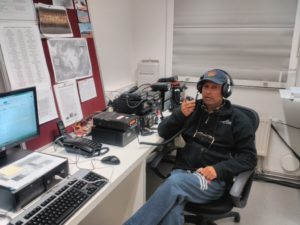 We remind our friend Ham radio Bhagwati Prasad Semwal, VU3BPZ (on the pic aside while at Maitri Base) when reading the article below, which gives our readers an idea on what means a Scientific campaign in Antarctica. Not only a pleasure of a selfy with penguins, not a vacation in a paradise but study, scientific projects, researches and experiments, hard life away from the normal activities at home.
We remind our friend Ham radio Bhagwati Prasad Semwal, VU3BPZ (on the pic aside while at Maitri Base) when reading the article below, which gives our readers an idea on what means a Scientific campaign in Antarctica. Not only a pleasure of a selfy with penguins, not a vacation in a paradise but study, scientific projects, researches and experiments, hard life away from the normal activities at home.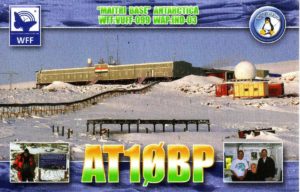 India’s Bharati Station in Antarctica. The continent is home to around 70 active research bases belonging to various countries. These bases house more than 4,000 people during the summer and around 1,000 people in winter. They spend an entire year in isolation, conducting research projects on the icy continent.
India’s Bharati Station in Antarctica. The continent is home to around 70 active research bases belonging to various countries. These bases house more than 4,000 people during the summer and around 1,000 people in winter. They spend an entire year in isolation, conducting research projects on the icy continent. This year, the winter team has 23 members deployed at the Bharati station. It is my responsibility to conduct regular health check-ups to ensure the physical and mental wellbeing of my team mates.
This year, the winter team has 23 members deployed at the Bharati station. It is my responsibility to conduct regular health check-ups to ensure the physical and mental wellbeing of my team mates. Amateur radio use in the UK has seen a “significant” rise during the coronavirus lockdown as people seek new ways of staying connected. The national body that represents users – the Radio Society of Great Britain (RSGB) – has said many people who formerly enjoyed the hobby are also returning to it.
Amateur radio use in the UK has seen a “significant” rise during the coronavirus lockdown as people seek new ways of staying connected. The national body that represents users – the Radio Society of Great Britain (RSGB) – has said many people who formerly enjoyed the hobby are also returning to it.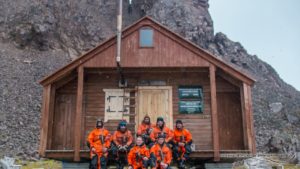 Located on ASPA 128, Demay refuge (wood hut) 62°13’ South, 58°26’30” West, is situated on a flat marine gravel terrace in Paradise Cove between Demay Point and Uchatka Point. The refuge can be reached both by Zodiac and by foot.
Located on ASPA 128, Demay refuge (wood hut) 62°13’ South, 58°26’30” West, is situated on a flat marine gravel terrace in Paradise Cove between Demay Point and Uchatka Point. The refuge can be reached both by Zodiac and by foot.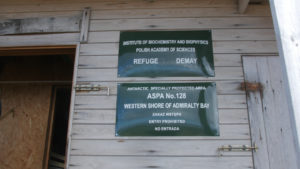 Their memories are preserved in the cottage guest book. The refuge contains two bunk beds, gas cooker, stove and even a shower. There is a VHF radio available with antenna on the rocks above the refuge. It is perfect for hiding from the cold, wind, blizzard and heavy rain. Those who stayed in the Paradise overnight can confirm that few earthy pleasures compare to a dawn on the veranda with a warm cup of tea in hands and a view over a calm horizon decorated with icebergs, waves breaking against the rocks of Demay Head, sleepy elephant seals and playful furseals.
Their memories are preserved in the cottage guest book. The refuge contains two bunk beds, gas cooker, stove and even a shower. There is a VHF radio available with antenna on the rocks above the refuge. It is perfect for hiding from the cold, wind, blizzard and heavy rain. Those who stayed in the Paradise overnight can confirm that few earthy pleasures compare to a dawn on the veranda with a warm cup of tea in hands and a view over a calm horizon decorated with icebergs, waves breaking against the rocks of Demay Head, sleepy elephant seals and playful furseals.
 The little old Hut at Lusitania Bay (54° 42′ South, 154°50′ East) just north of the king penguin colony. The huts are old Walrus aircraft engine packing crates, put in place in 1949. They served as field huts for many years and still could have, no doubt, except that the king penguin colonies at Sandy Bay and Lusitania Bay overtook them both and they were abandoned in favour of the new huts at Brothers Point and Waterfall Bay. (pic aside show Lusitania Bay’s penguin colony)
The little old Hut at Lusitania Bay (54° 42′ South, 154°50′ East) just north of the king penguin colony. The huts are old Walrus aircraft engine packing crates, put in place in 1949. They served as field huts for many years and still could have, no doubt, except that the king penguin colonies at Sandy Bay and Lusitania Bay overtook them both and they were abandoned in favour of the new huts at Brothers Point and Waterfall Bay. (pic aside show Lusitania Bay’s penguin colony)
 Brothers Point 54° 34.4′ South, 158° 55.1′ East (pic on the right show the Googie Hut at Brother’s point)
Brothers Point 54° 34.4′ South, 158° 55.1′ East (pic on the right show the Googie Hut at Brother’s point) Waterfall Bay Hut (pic on the left) located at 54° 41.5′ South, 158° 51.9′ East
Waterfall Bay Hut (pic on the left) located at 54° 41.5′ South, 158° 51.9′ East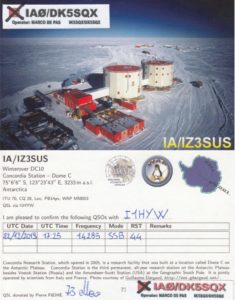 While talking of his Antarctic experience, Marco De Pas (DK5SQX-IK5SQX) is happy for such a great professional and human experience lived in the Icy Continent. -Our LIDAR a kind of optical radar that does “Cloud ranging” works perfectly and that’s great- Marco said!
While talking of his Antarctic experience, Marco De Pas (DK5SQX-IK5SQX) is happy for such a great professional and human experience lived in the Icy Continent. -Our LIDAR a kind of optical radar that does “Cloud ranging” works perfectly and that’s great- Marco said! Thanks to François F8DVD, we can show today an envelope with a rare Chapel of the Snow “cachet” from McMurdo Station (WAP USA-22)
Thanks to François F8DVD, we can show today an envelope with a rare Chapel of the Snow “cachet” from McMurdo Station (WAP USA-22)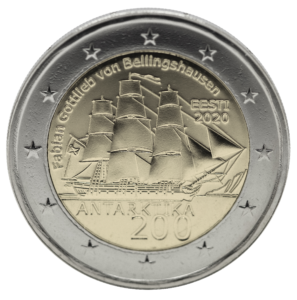 To commemorate this significant historical moment, Eesti Pank is issuing 750,000 two-euro circulation coins with a special Antarctica 200 design, of which 10,000 will be BU (brilliant uncirculated) quality and packaged as collector items on a coin card.
To commemorate this significant historical moment, Eesti Pank is issuing 750,000 two-euro circulation coins with a special Antarctica 200 design, of which 10,000 will be BU (brilliant uncirculated) quality and packaged as collector items on a coin card.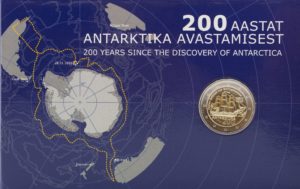 The coins are all legal tender throughout the euro area, so they can be used for payments like any other euro coin.
The coins are all legal tender throughout the euro area, so they can be used for payments like any other euro coin.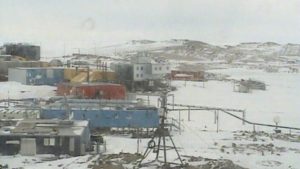 The 61st JARE (Japanese Antarctic Research Expedition) is on: It has started last February 2020 and will last till January 2021,
The 61st JARE (Japanese Antarctic Research Expedition) is on: It has started last February 2020 and will last till January 2021,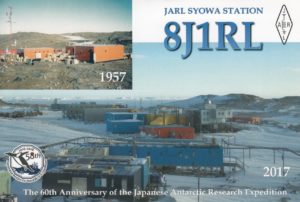
 “Italia Valley” Antarctic Memorial (MAVI) Cepparo-Bove, celebrates the day without forgetting its goal: a formal designation of a new HSM for the remaining ruins of the first Italian scientific research base in Antarctica, destroyed by the Argentine Navy, and abandoned for over 40 years. Ruins are still visible at Italia Valley.
“Italia Valley” Antarctic Memorial (MAVI) Cepparo-Bove, celebrates the day without forgetting its goal: a formal designation of a new HSM for the remaining ruins of the first Italian scientific research base in Antarctica, destroyed by the Argentine Navy, and abandoned for over 40 years. Ruins are still visible at Italia Valley.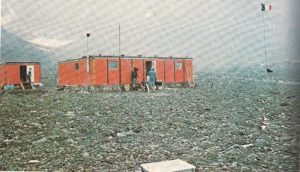 The activity aims to recover the historical memory of the Italia Valley in the Antarctic Peninsula, a strategic and naturalistic place where, in 1976, Renato Cepparo founded the first Italian Scientific Base in Antarctica (pic aside), which he named after the nineteenth-century explorer Giacomo Bove, brave officer of the Italian Royal Navy.
The activity aims to recover the historical memory of the Italia Valley in the Antarctic Peninsula, a strategic and naturalistic place where, in 1976, Renato Cepparo founded the first Italian Scientific Base in Antarctica (pic aside), which he named after the nineteenth-century explorer Giacomo Bove, brave officer of the Italian Royal Navy.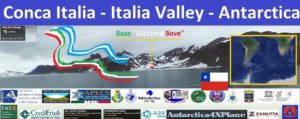 ICOMOS works for the conservation and protection of cultural heritage places. It is the only global non-government organization of this kind, which is dedicated to promoting the application of theory, methodology, and scientific techniques to the conservation of the architectural and archaeological heritage.
ICOMOS works for the conservation and protection of cultural heritage places. It is the only global non-government organization of this kind, which is dedicated to promoting the application of theory, methodology, and scientific techniques to the conservation of the architectural and archaeological heritage. For more than 116 years, men and women (civilians and military) have been working in and for Argentina’s Antarctica, revealing the secrets of this frozen and mysterious land, carrying out important national and international scientific missions.
For more than 116 years, men and women (civilians and military) have been working in and for Argentina’s Antarctica, revealing the secrets of this frozen and mysterious land, carrying out important national and international scientific missions.
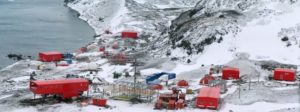 Although there have been no confirmed Covid-19 cases in Earth’s southernmost continent, the disease has nonetheless taken its toll on those there. Just ask the researchers and members of the military who recently experienced major difficulties in making it back home from the two Spanish bases in Antarctica.
Although there have been no confirmed Covid-19 cases in Earth’s southernmost continent, the disease has nonetheless taken its toll on those there. Just ask the researchers and members of the military who recently experienced major difficulties in making it back home from the two Spanish bases in Antarctica.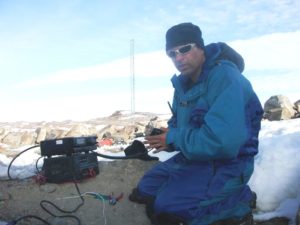 Bhagwati Prasad ,VU3BPZ is an Antarctic veteran. Several times in Antarctica, active from the Indian Base of Maitri (WAP IND-Ø3), Bharati Station (WAP IND-Ø4) and Indian Bay Camp (WAP IND-Ø2). See:
Bhagwati Prasad ,VU3BPZ is an Antarctic veteran. Several times in Antarctica, active from the Indian Base of Maitri (WAP IND-Ø3), Bharati Station (WAP IND-Ø4) and Indian Bay Camp (WAP IND-Ø2). See: 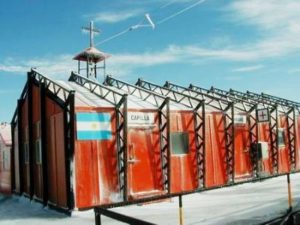 On April 16, 1996, a solemn ceremony was held at Marambio Base (WAP ARG-21), where the Military (Castrense) Bishop of the Argentine Republic in Solemn Pontifical, proceeded to bless and inaugurate the Oratory of the Base, placed under the dedication of the Blessed Virgin of Luján
On April 16, 1996, a solemn ceremony was held at Marambio Base (WAP ARG-21), where the Military (Castrense) Bishop of the Argentine Republic in Solemn Pontifical, proceeded to bless and inaugurate the Oratory of the Base, placed under the dedication of the Blessed Virgin of Luján
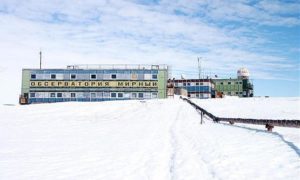 Alexander Solodov, RX3ABI arrived at Mirny Base (WAP RUS-Ø7) on last mid March and has just started to be on air signing RI1ANM.
Alexander Solodov, RX3ABI arrived at Mirny Base (WAP RUS-Ø7) on last mid March and has just started to be on air signing RI1ANM. The Australian Antarctic Division will use the MPV Everest to resupply its Antarctic stations and sub-Antarctic Macquarie Island next summer.
The Australian Antarctic Division will use the MPV Everest to resupply its Antarctic stations and sub-Antarctic Macquarie Island next summer.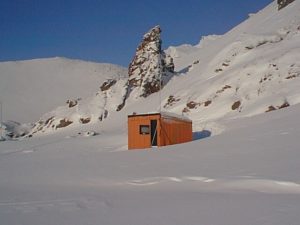 Located at 68° 07’53” South, 67°10’16” West, “Refuge 17 de Agosto” is an Antarctic refuge located in the north east of the Millerand Island in the Marguerite Bay, on Fallières Coast.
Located at 68° 07’53” South, 67°10’16” West, “Refuge 17 de Agosto” is an Antarctic refuge located in the north east of the Millerand Island in the Marguerite Bay, on Fallières Coast.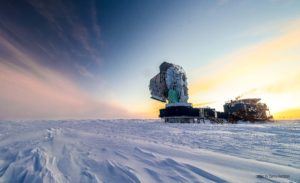 The sun, won’t rise again until September.
The sun, won’t rise again until September.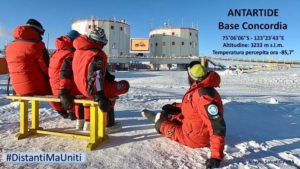
 Beyond all names that are attributed to it, Point Wild on Elephant Island, hosts the bust of Luis Antonio Pardo Villalòn, the Chilean Navy Officer who, in August 30th 1916, commanded the steam Tug Yelcho to rescue the 22 stranded crewmen of Sir Ernast Shackleton’s expedition who survived the wreck of the ship Endurance living for four and one half months in this island.
Beyond all names that are attributed to it, Point Wild on Elephant Island, hosts the bust of Luis Antonio Pardo Villalòn, the Chilean Navy Officer who, in August 30th 1916, commanded the steam Tug Yelcho to rescue the 22 stranded crewmen of Sir Ernast Shackleton’s expedition who survived the wreck of the ship Endurance living for four and one half months in this island.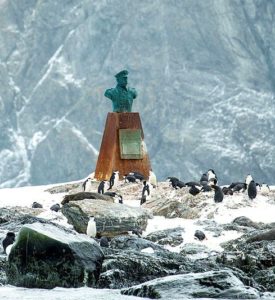 seaweed untill they were finally rescued by Shackleton aboard the Chilean ship Yelcho.
seaweed untill they were finally rescued by Shackleton aboard the Chilean ship Yelcho.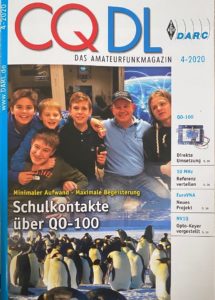 On the April 2020 issue, the German CQ-DL Magazine dedicates several pages to report the QO-100 activity with particular regards to the contact made from Neumayer III Station (WAP DEU-Ø8) and the students at school.
On the April 2020 issue, the German CQ-DL Magazine dedicates several pages to report the QO-100 activity with particular regards to the contact made from Neumayer III Station (WAP DEU-Ø8) and the students at school.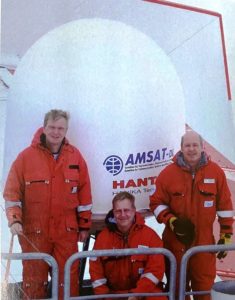
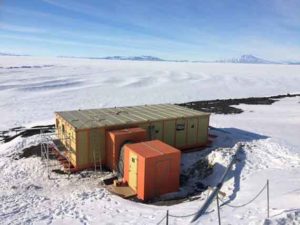 save Sir Ed’s hut in Antarctica is now largely complete
save Sir Ed’s hut in Antarctica is now largely complete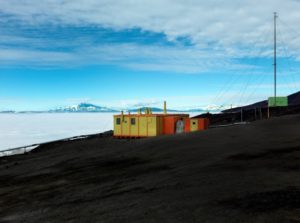 The “A” Hut has been designated a Historic Site or Monument (HSM 75), following a proposal by New Zealand to the Antarctic Treaty Consultative Meeting.
The “A” Hut has been designated a Historic Site or Monument (HSM 75), following a proposal by New Zealand to the Antarctic Treaty Consultative Meeting. For several weeks, scientists working at Vernadsky in Antarctica have been surrounded by what they call “raspberry snow”. Images released by Ukraine’s Ministry of Education and Science on Monday showed the phenomenon, which is caused by microscope snow algae when weather conditions are favorable during Antarctica’s summer months.
For several weeks, scientists working at Vernadsky in Antarctica have been surrounded by what they call “raspberry snow”. Images released by Ukraine’s Ministry of Education and Science on Monday showed the phenomenon, which is caused by microscope snow algae when weather conditions are favorable during Antarctica’s summer months.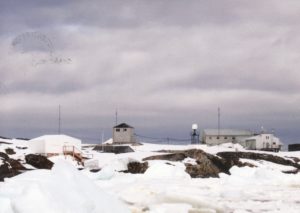

 XR8RRC/p – WAP CHL-13
XR8RRC/p – WAP CHL-13 Antarctica’s bicentenary year, a right time to join UKAHT, a site that keeps the Antarctic enthusiast up to date with lots of exciting work in Antarctica and beyond.
Antarctica’s bicentenary year, a right time to join UKAHT, a site that keeps the Antarctic enthusiast up to date with lots of exciting work in Antarctica and beyond.
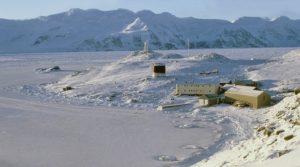
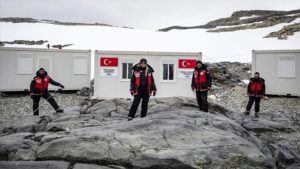 Turkish scientists continue their scientific research on Horseshoe Island in Antarctica. After the construction of Turkey’s first temporary science Base on the island (67°49’40” South, 67°12’08” West), the Team welcomed a group of guests from Chile, Bulgaria, the Czech Republic and Ukraine for the first time. The six guest scientists did work together with the 24-member of the Turkish research Team joins 15 scientific projects in the Earth, life, and marine sciences.
Turkish scientists continue their scientific research on Horseshoe Island in Antarctica. After the construction of Turkey’s first temporary science Base on the island (67°49’40” South, 67°12’08” West), the Team welcomed a group of guests from Chile, Bulgaria, the Czech Republic and Ukraine for the first time. The six guest scientists did work together with the 24-member of the Turkish research Team joins 15 scientific projects in the Earth, life, and marine sciences.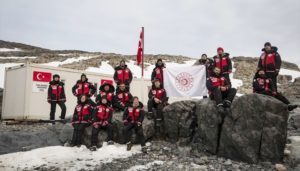 “The GNSS satellite navigation base station was set up within the framework of the fourth Turkish scientific expedition to Antarctica” said Turkish Industry and Technology Minister Mustafa Varank, as quoted by the national Anadolu news agency. “A group of specialists from the Turkish General Directorate of Mapping has built Turkey’s first GNSS base station abroad.”
“The GNSS satellite navigation base station was set up within the framework of the fourth Turkish scientific expedition to Antarctica” said Turkish Industry and Technology Minister Mustafa Varank, as quoted by the national Anadolu news agency. “A group of specialists from the Turkish General Directorate of Mapping has built Turkey’s first GNSS base station abroad.”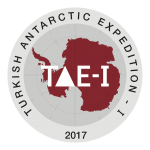 (1 nmi) long and 60 metres (200 ft) high, which is mainly ice covered and is the largest of the Faure Islands, an archipelago lying in Marguerite Bay off the west coast of Graham Land.
(1 nmi) long and 60 metres (200 ft) high, which is mainly ice covered and is the largest of the Faure Islands, an archipelago lying in Marguerite Bay off the west coast of Graham Land.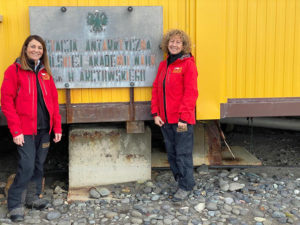 Prof. Carla Caruso and Dr. Laura Bertini (pic aside) of the Department of Ecological and Biological Sciences of the University of Tuscia in Viterbo (Italy) will be back home next march 15th after a month-long mission in Antarctica.
Prof. Carla Caruso and Dr. Laura Bertini (pic aside) of the Department of Ecological and Biological Sciences of the University of Tuscia in Viterbo (Italy) will be back home next march 15th after a month-long mission in Antarctica.